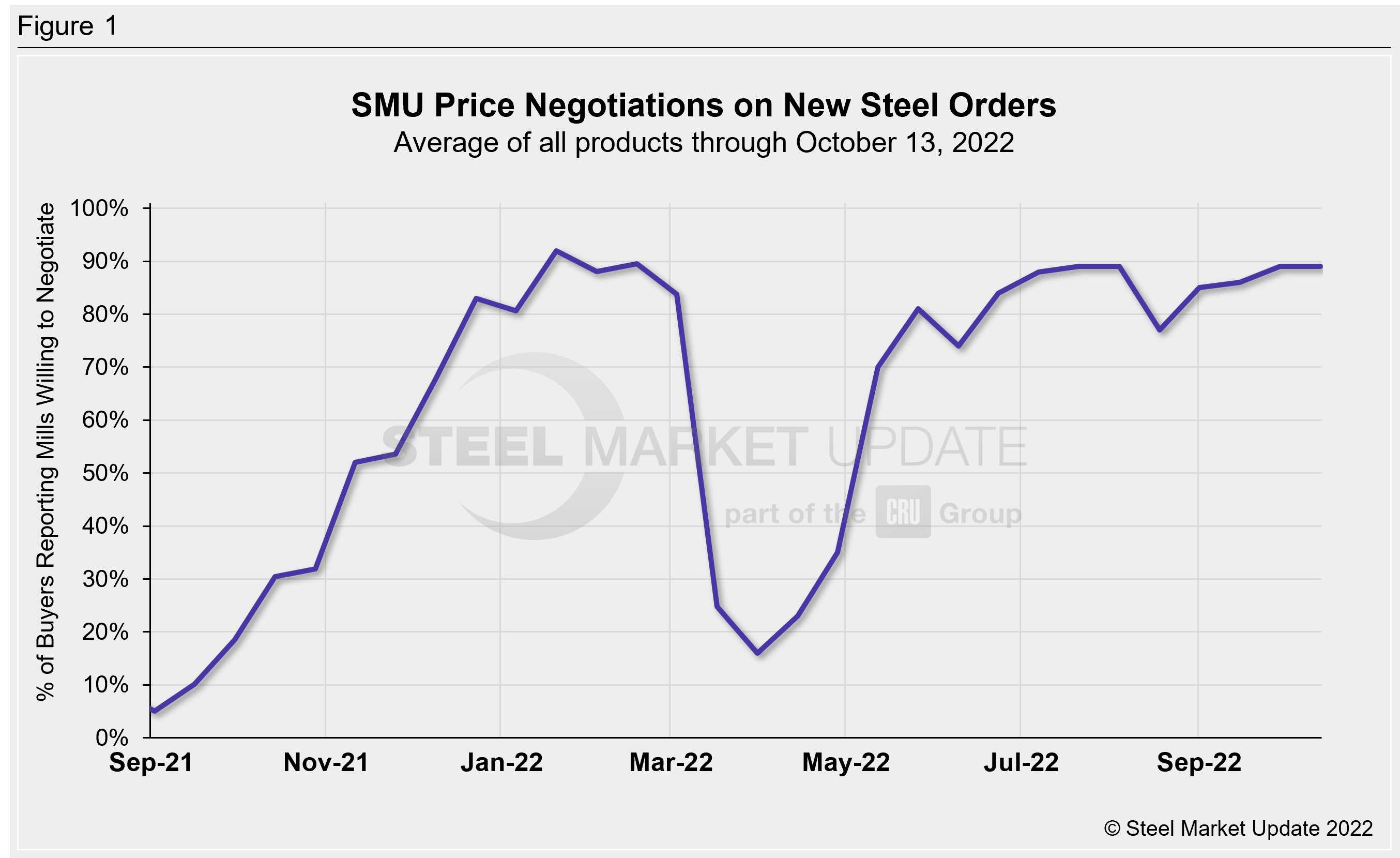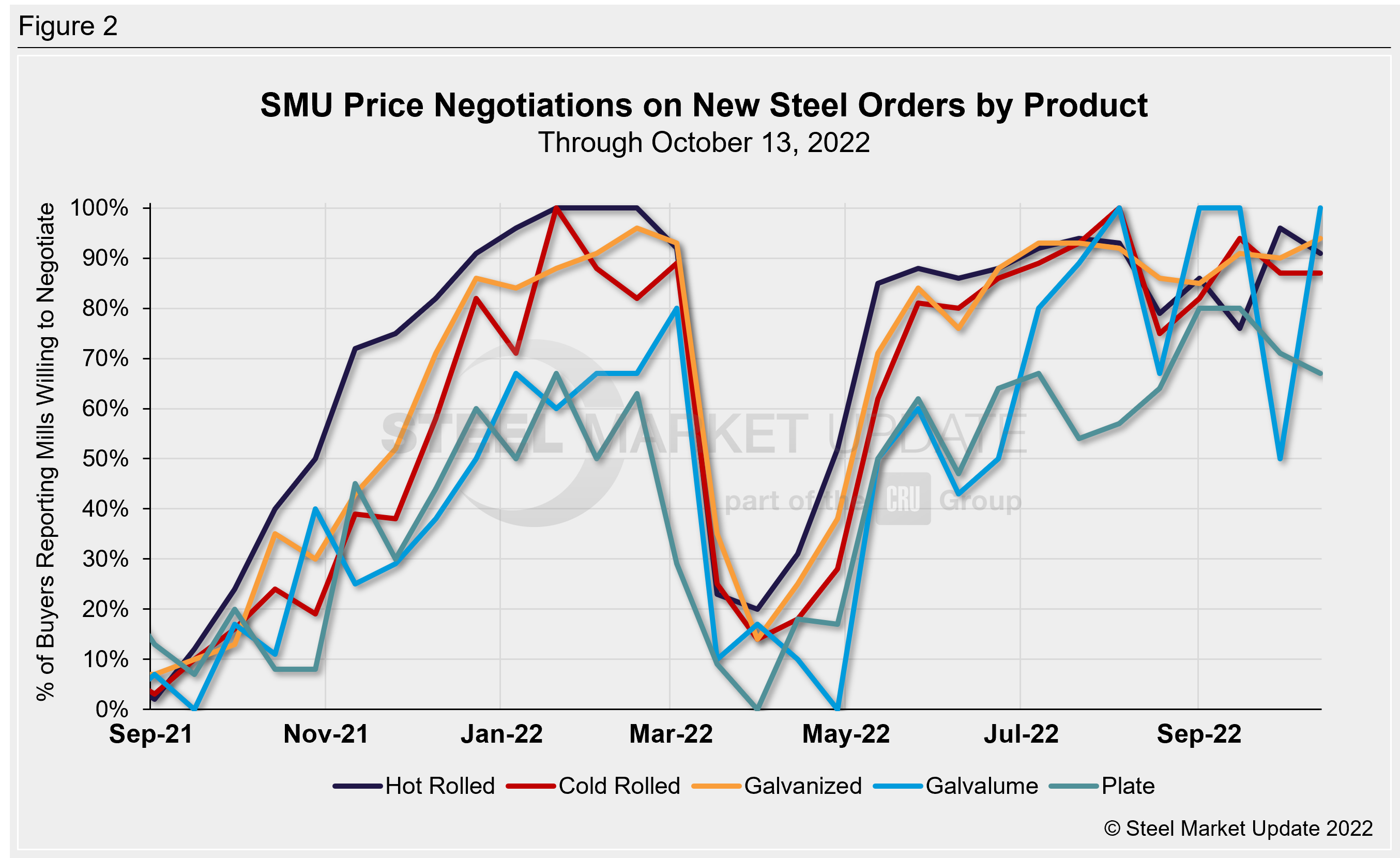SMU Data and Models

Steel Mill Negotiations: Buyers Still Have the Upper Hand
Written by Brett Linton
October 13, 2022
With steel prices continuing to ease, buyers clearly hold the upper hand in price negotiations with mills. Market dynamics have turned 180 degrees in the past six months, from a seller’s market in March and April to a strong buyer’s market today. According to our latest steel market survey, a high percentage of buyers continue to report that mills are willing to talk price to secure an order. That high willingness to negotiate has been evident in each of our market checks since May.
Steel Market Update polls hundreds of steel buyers every week, asking this question: Do you find domestic mills willing to negotiate spot pricing on new orders? On average this week, 89% of steel buyers reported that mills were willing to negotiate lower prices on new orders. As shown in Figure 1, this negotiation rate is in line with what we reported in late September. It remains near the previous high levels seen in July and early August. Recall we saw negotiation rates as low as 16% in March.

Figure 2 below shows negotiation rates broken down by product for the past year. Ninety-one percent of hot rolled buyers surveyed respond that mills are willing to negotiate lower prices. This is down from 96% two weeks prior, which was the highest reading seen since February. One month ago, our hot rolled negotiation rate was 76%. Negotiation rates were previously in the 92–94% range in July and early August.
For cold rolled, 87% of buyers polled reported that mills were willing to bargain, unchanged from two week ago and down from 94% one month prior. Ninety-four percent of galvanized buyers reported that mill prices are negotiable, up from 90% in late September. Galvanized negotiation rates have been relatively stable for the last four months, ranging between 85–94%.
Galvalume negotiation rates tend to be more volatile due to the smaller market size. That caveat aside, 100% of respondents reported that mills are negotiable on new orders this week.
Negotiations have been slightly less common in the plate market but have generally increased since mid-July. Sixty-seven percent of buyers reported a willingness to negotiate this week, down from 71% two weeks prior and down from 80% a month ago. Plate negotiation rates had been between 54–67% for nearly two months prior to September. Recall we saw plate negotiation rates between 0–18% in March and April.
SMU’s Price Momentum Indicator was adjusted from Neutral to Lower on Oct. 11, in consideration of increased supply, weaker demand, and lower raw material costs. Our plate momentum indicator remains at Neutral.

Note: SMU surveys active steel buyers every other week to gauge the willingness of their steel suppliers to negotiate pricing. The results reflect current steel demand and changing spot pricing trends. SMU provides our members with a number of ways to interact with current and historical data. To see an interactive history of our Steel Mill Negotiations data, visit our website here.
By Brett Linton, Brett@SteelMarketUpdate.com

Brett Linton
Read more from Brett LintonLatest in SMU Data and Models

SMU Steel Survey: Sentiment Indices dip as buyer optimism softens
SMU’s Buyers’ Sentiment Indices experienced multi-point declines this week, though both remain positive and continue to reflect optimism among steel buyers for their companies' ability to be successful.

SMU Scrap Survey: Current Buyers’ Sentiment flat, Future Sentiment tumbles
SMU's Current Scrap Buyers' Sentiment Index remained flat this month, while the Future Sentiment Index declined.

SMU Survey: Steel mill lead times show diverging trends
Buyers responding to our latest market survey reported that sheet lead times continue to gradually decline from recent highs. Meanwhile, plate lead times increased to levels last seen one year ago.

SMU Survey: Mills unlikely to budge on price, buyers say
Four out of every five steel buyers who responded to our latest market survey say domestic mills are unwilling to negotiate on new order spot pricing. Mills have shown little flexibility on pricing for nearly two months.

SMU’s March at a glance
SMU’s Monthly Review provides a summary of our key steel market metrics for the previous month, with the latest data updated through March 31.
